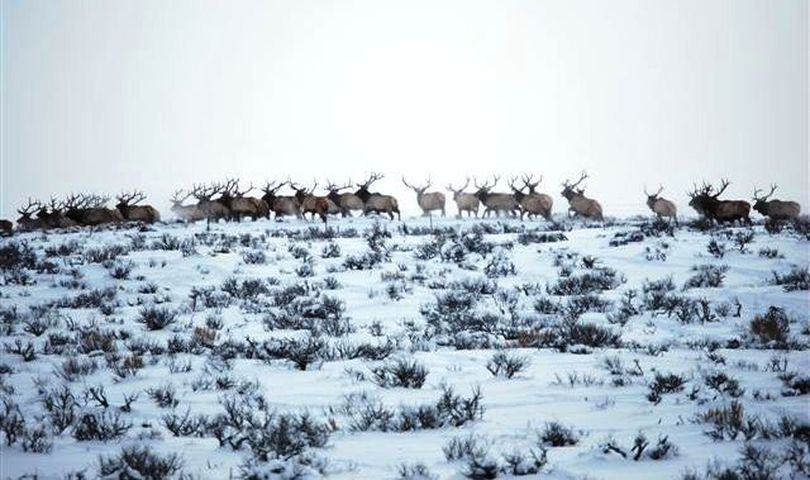Washington conservation projects earn Elk Foundation funding

WILDLIFE HABITAT -- Elk research at Mt. St. Helens and habitat improvements on four national forests and other public lands in Washington headline a just-announced slate of projects selected for 2011 grants from the Rocky Mountain Elk Foundation.
The far-east side of the state isn't overlooked, with prescribed burn habitat improvement projects set for Asotin, Stevens and Pend Oreille counties.
The new RMEF grants total $156,380 with an impact on up to 100,000 acres, officials said. The money usually is leveraged with money from other groups or agencies for more benefits on the ground
Read on for more details.
The 2011 wildlife habitat projects will affect Asotin, Cowlitz, Columbia, Garfield, Jefferson, Kittitas, Lewis, Pend Oreille, Skamania, and Stevens counties.
“Along with research on elk population densities and forage use at Mt. St. Helens, we’re also funding habitat projects like prescribe burns, forest thinning, weed treatments and guzzler installations. These projects could add well over 25,000 acres to the 391,805 acres that we’ve already helped to conserve or enhance for wildlife in Washington,” said David Allen, RMEF president and CEO.
Nationally, RMEF hopes to impact about 100,000 acres in 2011 to reach the 6 million-acre lifetime mark in lands conserved or enhanced for elk and other wildlife.
RMEF volunteers and fundraiser attendees do the groundwork for buiding the coffers that support the grands.
RMEF grants will help fund the following 2011 projects, listed by county:
Asotin County—Prescribe burn 1,200 acres to improve forage quality on elk summer range in Umatilla National Forest; enhance grassland habitat by treating new outbreaks of invasive weeds (rush skeletonweed, sulfur cinquefoil, spotted knapweed, etc.) countywide, plus targeted projects to reduce weeds on 938 acres and reseed native grasses along the Grande Ronde River and to treat Mediterranean sage on 300 acres of public land in the heart of Asotin County; continue multi-year project to treat 20,204 acres of weeds in the Blue Mountains Wildlife Area Complex.
Cowlitz County—Begin a two-year research project on forage quality and elk population densities in late-succession forest habitat surrounding Mt. St. Helens (also affects Lewis and Skamania counties); lime, fertilize and reseed native grasses on state lands in the Mt. St. Helens area.
Columbia County—Treat 1,100 acres of yellow starthistle and spotted knapweed to improve habitat for elk and other wildlife in the Jim Creek/North Touchet River area; treat noxious weeds on 1,450 acres in Robinette Mountain area.
Garfield County—Install 1,800-gallon guzzler as a critical wildlife drinking station on Abels Ridge in the W. T. Wooten Wildlife Area.
Jefferson County—Thin 247 acres of dense forest to improve forage in high-use elk areas in Matheny Creek area of Olympic National Forest.
Kittitas County—Redevelop nine springs as critical water sources for elk that winter in the arid Quilomene Wildlife Area.
Lewis County—Enhance elk forage areas by thinning (pre-commercial) forest plantations in the Davis and Greenhorn creek areas of Gifford Pinchot National Forest.
Pend Oreille County—Improve elk forage areas by removing encroaching conifers using prescribed fire in Sullivan Creek area of Colville National Forest.
Skamania County—Treat noxious weeds and prescribe burn retired nursery fields to improve forage for elk and deer in the Wind River area of Gifford Pinchot National Forest.
Stevens County—Rejuvenate browse vegetation for elk and reduce wildfire fuels by prescribe burning 355 acres in the Cottonwood Creek area of Colville National Forest.
Projects are selected for grants using science-based criteria and a committee of RMEF volunteers and staff along with representatives from partnering agencies and universities.
Partners for 2011 projects in Washington include Bureau of Land Management (BLM), U.S. Fish and Wildlife Service, U.S. Forest Service, Washington Dept. of Fish and Wildlife, University of Alberta, other agencies, organizations, corporations and landowners.
Since 1985, RMEF and its partners have completed 449 different conservation and education projects in Washington with a combined value of more than $102 million.
About the Rocky Mountain Elk Foundation:
Snowy peaks, dark timber basins and grassy meadows. RMEF is leading an elk country initiative that has conserved or enhanced habitat on over 5.9 million acres—a land area equivalent to a swath three miles wide and stretching along the entire Continental Divide from Canada to Mexico. RMEF also works to open, secure and improve public access for hunting, fishing and other recreation. Get involved at www.rmef.org or 800-CALL ELK.
